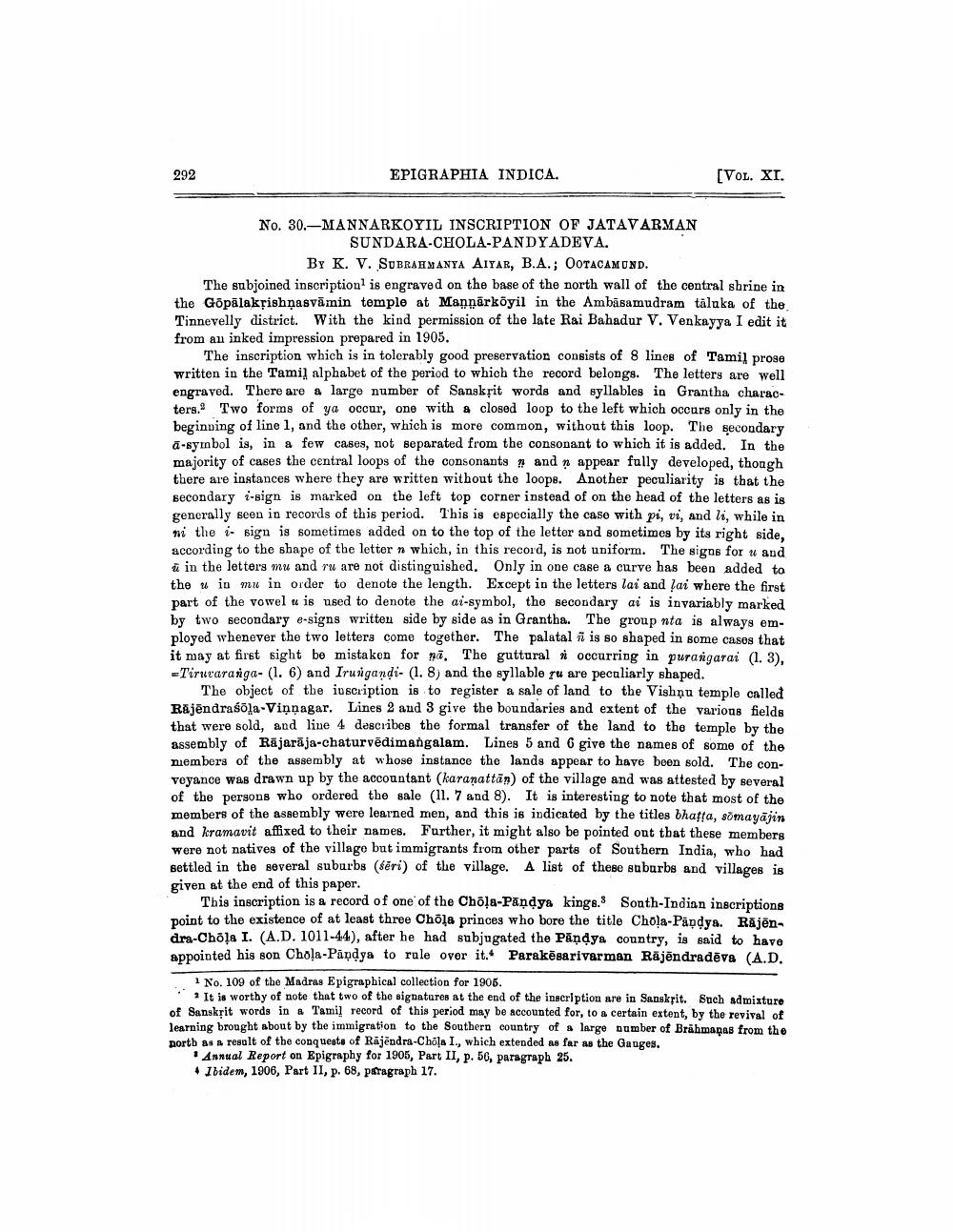________________
292
EPIGRAPHIA INDICA.
[VOL. XI.
No. 30.-MANNARKOYIL INSCRIPTION OF JATAVARMAN
SUNDARA-CHOLA-PANDYADEVA.
BY K. V. SUBRAHMANYA AIYAR, B.A.; OOTACAMUND. The subjoined inscription is engraved on the base of the north wall of the central shrine in the Gopālakṣishņasvāmin temple at Mannārköyil in the Ambasamudram talaka of the Tinnevelly district. With the kind permission of the late Rai Bahadur V. Venkayya I edit it from an inked impression prepared in 1905.
The inscription which is in tolerably good preservation consists of 8 lines of Tamil proge written in the Tamil alphabet of the period to which the record belongs. The letters are well engraved. There are a large number of Sanskrit words and syllables in Grantha characters. Two forms of ya occur, one with a closed loop to the left which occurs only in the beginning of line 1, and the other, which is more common, without this loop. The secondary ā-symbol is, in a few cases, not separated from the consonant to which it is added. In the majority of cases the central loops of the consonants ? and appear fully developed, though there are instances where they are written without the loope. Another peculiarity is that the secondary e-sign is marked on the left top corner instead of on the head of the letters as is generally seen in records of this period. This is especially the case with pi, vi, and li, while in ni the j- sign is sometimes added on to the top of the letter and sometimes by its right side, according to the shape of the letter n which, in this record, is not uniform. The sigas for u and ū in the letters mu and ru are not distinguished. Only in one case a curve has been added to the w in mu in order to denote the length. Except in the letters lai and sai where the first part of the vowel is used to denote the ai-symbol, the secondary ai is invariably marked by two secondary e-signs written side by side as in Grantha. The group nta is always employed whenever the two letters come together. The palatal i is so shaped in some cases that it may at first sight be mistaken for mā. The guttural occurring in purangarai (1. 3), =Tiruvaranga- (1. 6) and Irurgandi- (1. 8) and the syllable ru are peculiarly shaped.
The object of the inscription is to register a sale of land to the Vishnu temple called Rājēndrasola-Viņnagar. Lines 2 and 3 give the boundaries and extent of the various fields that were sold, and line 4 describes the formal transfer of the land to the temple by the assembly of Rajaraja-chaturvēdimangalam. Lines 5 and give the names of some of the niembers of the assembly at whose instance the lands appear to have boen sold. The conveyance was drawn up by the accountant (karanattan) of the village and was attested by several of the persons who ordered the sale (11. 7 and 8). It is interesting to note that most of the members of the assembly were learned men, and this is indicated by the titles bhatta, somayājin and kramavit affixed to their names. Further, it might also be pointed out that these members were not natives of the villago but immigrants from other parts of Southern India, who had settled in the several suburbs (sēri) of the village. A list of these suburbs and villages is given at the end of this paper.
This inscription is a record of one of the Chola-Pandya kings. South-Indian inscriptions point to the existence of at least three Chola princes who bore the title Choa-Pandya. Rajēndra-Chola I. (A.D. 1011-44), after he had subjugated the Pandya country, is said to have appointed his son Chola-Pandya to rule over it. Parakësarivarman Räjëndradēva (A.D. . No. 109 of the Madras Epigraphical collection for 1905. . It is worthy of note that two of the signatures at the end of the inscription are in Sanskrit. Such admixture of Sanskrit words in a Tamil record of this period may be accounted for, to a certain extent, by the revival of learning brought about by the immigration to the Southern country of a large bumber of Brahmapas from the nortb as a result of the conqueste of Rajendra-Chola I., which extended as far as the Ganges.
* Annual Report on Epigraphy for 1905, Part II, p. 56, paragraph 25.
Ibidem, 1906, Part II, p. 68, paragraph 17.




